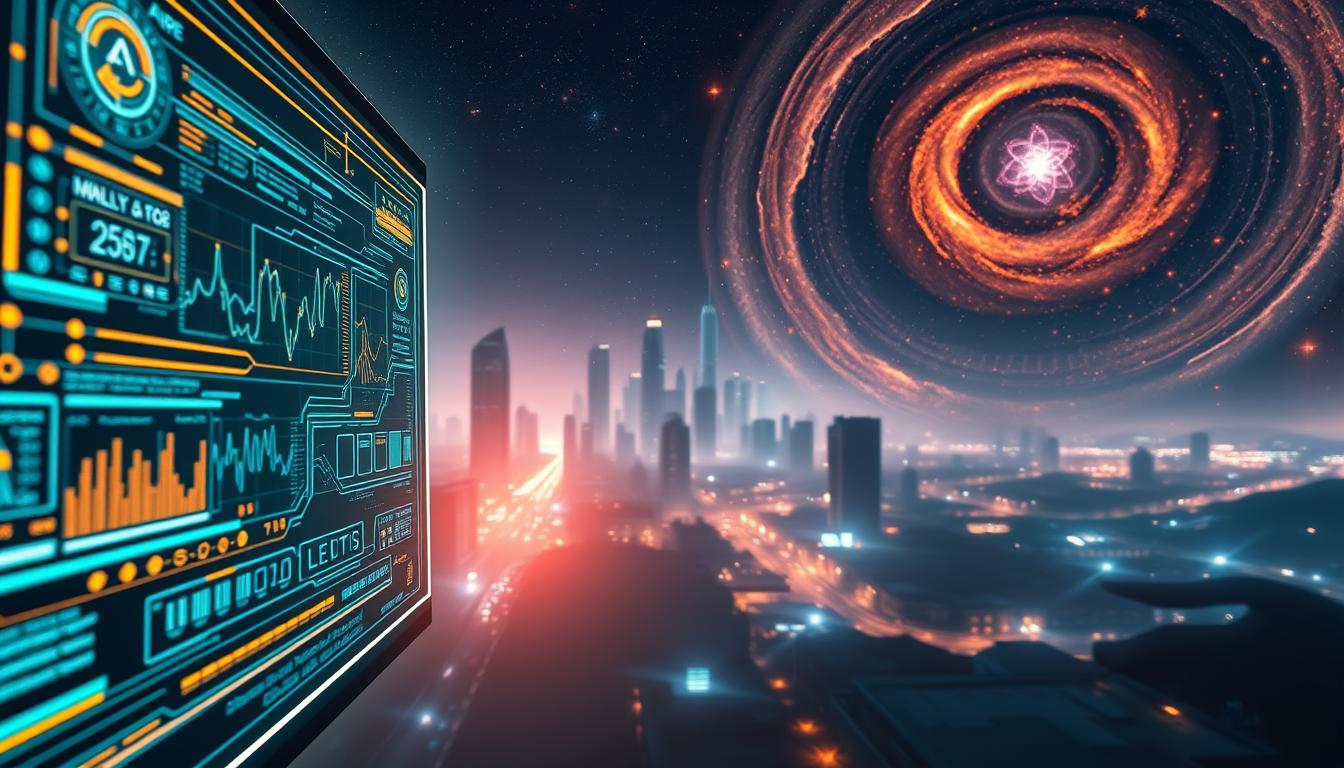The collaboration between advanced AI tools has opened new doors for creativity. Imagine transforming simple ideas into breathtaking visuals with just a few clicks. This guide is designed to help everyone, from beginners to professionals, explore the world of AI-driven art.
With the integration of cutting-edge technologies, users can now create anything from product photography to surreal digital landscapes. The possibilities are endless, and the results are stunning. This guide will walk you through over 15 art styles, providing practical templates to get you started.
Since its launch in October 2023, the latest version of this AI tool has made it easier than ever to generate detailed and high-quality images. While there are some limits, like the 50-image cap for premium users, the advantages are clear. Compared to other platforms, this tool excels in understanding and executing complex text instructions.
Key Takeaways
- Discover how AI tools can transform your creative process.
- Learn to create stunning visuals for various applications.
- Explore over 15 art styles with practical templates.
- Understand the benefits of the latest AI integration.
- Compare features with other platforms for better results.
Introduction: Unlocking the Power of ChatGPT and DALL-E
Combining advanced AI models unlocks endless possibilities for artistic expression. These tools have transformed how we approach creativity, making it easier to turn ideas into stunning visuals. Whether you’re a beginner or a professional, this guide will help you explore the potential of AI-driven art.

Why AI Tools Are a Game-Changer
The latest models have made significant breakthroughs in understanding and executing complex instructions. Compared to earlier versions, they excel in rendering text and handling diverse aspect ratios. This ensures your creations are both detailed and visually appealing.
One standout feature is the ability to enhance basic inputs automatically. This saves time and ensures high-quality results. Additionally, the platform is cost-effective, offering competitive pricing compared to other services.
How This Guide Will Help You
This guide provides practical templates and examples to help you create stunning visuals. From surreal landscapes to product photography, you’ll learn how to leverage AI tools effectively. With step-by-step instructions, you’ll master the art of image generation in no time.
For instance, imagine creating a bedtime story illustration like “super-duper sunflower hedgehog” with ease. The integration of these tools ensures your ideas come to life with precision and creativity.
Understanding the Basics of DALL-E Prompting
Effective image generation begins with crafting detailed and precise prompts. Whether you’re creating surreal landscapes or product photography, the quality of your input directly impacts the output. This section will guide you through the essentials of writing prompts that deliver stunning results.

Key Elements of an Effective DALL-E Prompt
To create compelling visuals, your prompt should include specific elements. These ensure the AI understands your vision and produces the desired outcome. Here are the key components:
- Image Type: Define the category, such as portrait, landscape, or abstract.
- Subject: Clearly describe the main focus, like a futuristic robot or a serene beach.
- Location: Set the scene with details like a bustling city or a quiet forest.
- Lighting: Specify the mood with terms like golden hour or dramatic shadows.
- Emotion: Convey feelings, such as joy, mystery, or nostalgia.
- Style: Choose an art style, from impressionism to minimalism.
By including these elements, you can guide the AI to generate images that match your creative vision.
How ChatGPT Enhances Your Prompt Creation Process
Writing detailed prompts can be challenging, but AI tools like ChatGPT simplify the process. For example, a basic idea like “futuristic AI robot” can be transformed into a 75-word detailed prompt. This ensures the AI has all the information it needs to produce high-quality results.
ChatGPT also helps with brand consistency by suggesting color palettes and avoiding unwanted elements through negative prompting. For instance, adding “no misspelled text” ensures professional-looking outputs.
Additionally, ChatGPT’s interface is user-friendly, making it accessible for both beginners and professionals. Whether you’re using the API or the standard interface, the tool adapts to your needs, offering flexibility and efficiency.
Street Photography: Capturing Everyday Moments
Street photography brings the essence of everyday life into focus. It’s about capturing candid moments that tell stories of people, places, and emotions. Whether it’s a bustling city sidewalk or a quiet rural street, this art form highlights the beauty of the ordinary.
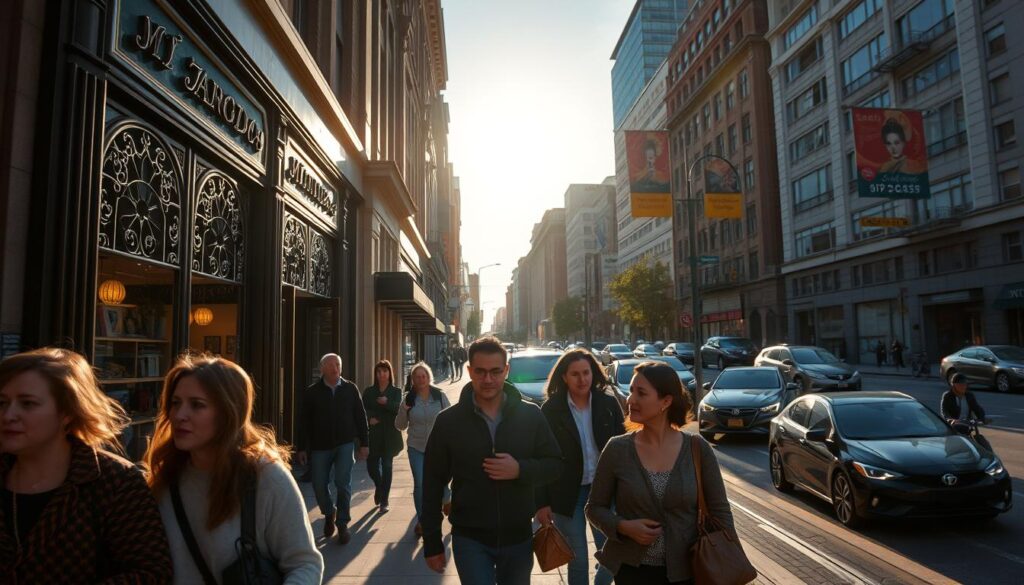
To create compelling street photography, attention to details is key. Lighting, composition, and timing all play a role in transforming a simple scene into a powerful image. Below, we’ll explore how to craft effective prompts and techniques to elevate your work.
Prompt Template for Street Photography
Here’s a template to help you get started:
- Subject: A street musician performing on a busy corner.
- Location: A vibrant urban sidewalk with colorful storefronts.
- Lighting: Warm late afternoon light, creating long shadows.
- Emotion: Joy and energy from the crowd’s reactions.
- Style: Candid and natural, with a focus on realism.
Example: A Busy City Sidewalk Scene
Imagine a scene where a street musician plays guitar under the golden hour light. The crowd gathers, their faces lit with joy. This example showcases how lighting and subject interaction can bring a scene to life.
| Aspect | Urban Street Photography | Rural Street Photography |
|---|---|---|
| Setting | Busy sidewalks, skyscrapers, and crowds. | Quiet streets, open fields, and small-town charm. |
| Lighting | Artificial and natural light mix. | Natural light dominates, especially during golden hour. |
| Mood | Energetic and fast-paced. | Calm and serene. |
By understanding these differences, you can tailor your approach to suit the environment. Whether you’re in a bustling city or a quiet village, street photography offers endless opportunities to capture the essence of life.
HDR Photography: Vibrant and Lifelike Images
HDR photography transforms ordinary scenes into vibrant, lifelike images. By combining multiple exposures, it captures a wider range of light and shadow, enhancing details and quality. This technique is perfect for creating stunning landscapes and dynamic visuals.
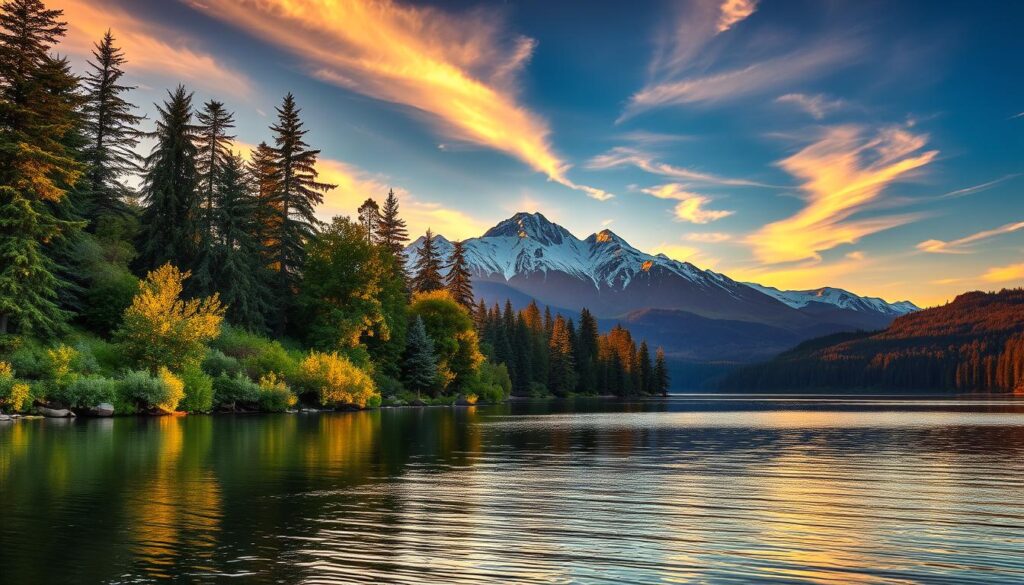
Technical Aspects of HDR Photography
HDR works by blending several photos taken at different exposures. This process ensures both highlights and shadows are well-balanced. AI tools replicate this technique by simulating multi-exposure blending, delivering professional-grade results.
For example, a prompt like “woman in sundress under golden hour daylight” can produce a breathtaking image. The AI adjusts lighting and color to mimic HDR effects, ensuring every detail stands out.
Dynamic Range Comparisons
Different AI models handle dynamic range differently. Some excel in shadow recovery, while others focus on highlight preservation. Understanding these differences helps you choose the right tool for your project.
Here’s a quick comparison:
- Shadow Recovery: Ensures dark areas retain clarity.
- Highlight Preservation: Prevents bright areas from overexposure.
- Color Grading: Adds depth and mood to the scene.
Applications in Real Estate Photography
HDR is widely used in real estate to showcase properties. It highlights architectural details and creates inviting interiors. AI-generated HDR offers a cost-effective alternative to traditional methods, with pricing as low as $0.08 per 1024×1024 image.
“HDR photography brings out the best in every scene, making it a must-have tool for professionals.”
Smartphone HDR vs. AI-Generated Versions
While smartphone HDR is convenient, AI-generated versions offer superior quality and control. AI tools allow precise adjustments, such as color grading and multi-exposure blending, ensuring every image meets your standards.
For instance, AI can simulate golden hour lighting in a country field, creating a warm and inviting landscape. This level of customization is unmatched by smartphone cameras.
Anime and Manga Art: Expressive and Dynamic
Anime and manga art captivate audiences with their expressive and dynamic visuals. This unique style blends vibrant colors, intricate details, and emotional storytelling to create unforgettable designs. Whether you’re a fan or an artist, understanding its features can elevate your creative process.
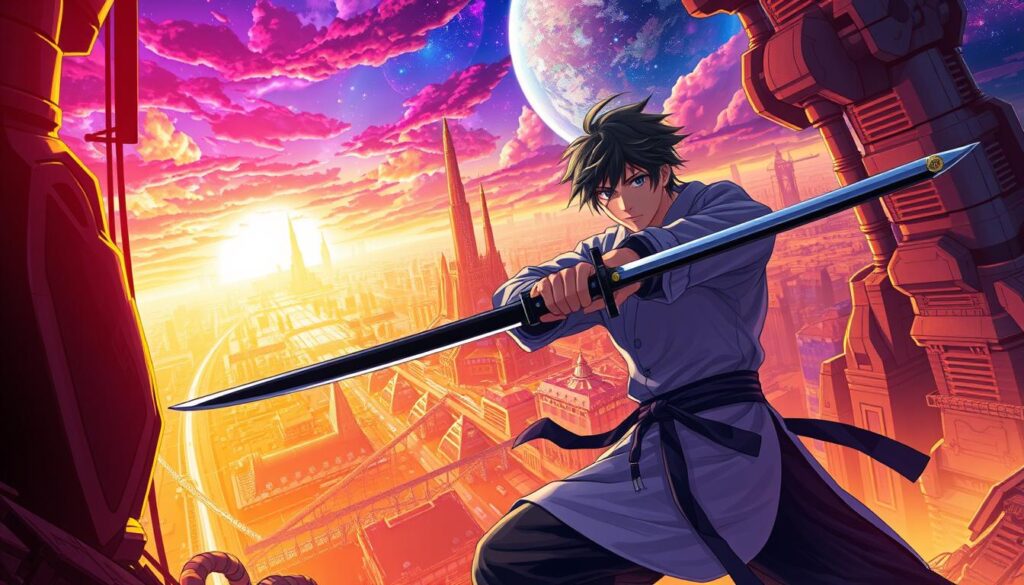
Prompt Template for Anime Art
Creating compelling anime art starts with a clear vision. Use this template to guide your generation process:
- Style: Choose between vibrant colors or black-and-white shading.
- Subject: Focus on characters, landscapes, or action scenes.
- Emotion: Convey feelings like determination, joy, or mystery.
- Details: Add cultural references or futuristic elements.
Example: A Futuristic Cityscape
Imagine a young warrior overlooking a futuristic city. The scene combines bold architecture, glowing neon lights, and a sense of adventure. This example showcases how anime art can bring complex worlds to life.
Key elements like facial proportions and expressions play a crucial role. For instance, exaggerated eyes and dynamic poses add emotional depth. Comparing Studio Ghibli’s whimsical designs to Cyberpunk’s gritty aesthetics highlights the versatility of this art form.
Cultural references are another important aspect. Avoid stereotypes and focus on authentic details. For manga, integrating speech bubbles and panel-by-panel storytelling ensures clarity and flow. Character design sheets help maintain consistency across your work.
Whether you’re creating Shonen action or Shojo romance, understanding these features ensures your art resonates with audiences. Anime and manga art is more than just visuals—it’s a celebration of creativity and storytelling.
High-Definition Product Photography: Showcasing Details
High-definition product photography brings every detail to life, making it essential for modern marketing. Whether you’re selling handmade crafts or high-end electronics, the quality of your images can make or break a sale. This section explores how to create stunning visuals that highlight the unique features of your products.
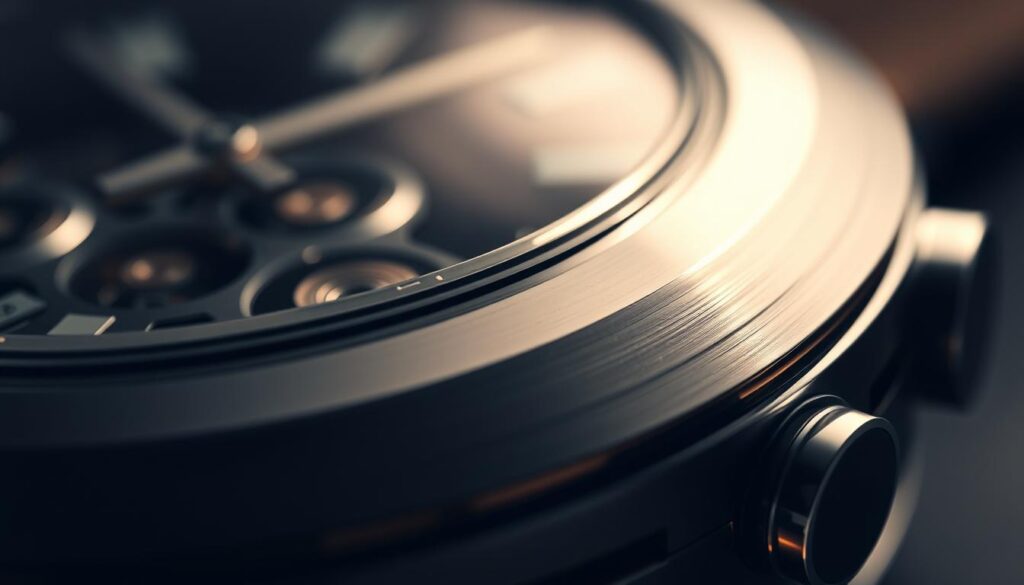
Prompt Template for Product Photography
To create compelling product images, start with a clear and detailed prompt. Here’s a template to guide you:
- Product: Describe the item, such as “Cowboy Candy on a rustic table.”
- Lighting: Specify the setup, like “softbox lighting for a glossy appearance.”
- Background: Choose a setting, such as “natural wood texture.”
- Style: Decide between e-commerce or artistic shots.
- Details: Highlight key features, like “matte finish” or “glossy texture.”
Example: Rustic Table Setting
Imagine a jar of Cowboy Candy placed on a rustic wooden table. The softbox lighting enhances the glossy textures of the jar, while the natural wood background adds warmth. This setup creates a visually appealing image that showcases the product’s quality and designs.
For e-commerce, consider flat lay shots that highlight the product’s dimensions. For artistic purposes, 360-degree spins can add dynamism. Seasonal styling, like holiday-themed backdrops, can also make your products stand out.
“High-definition photography ensures every detail is visible, helping customers make informed decisions.”
By mastering these techniques, you can create product images that not only attract attention but also drive sales. Whether you’re working with natural light or advanced setups, the key is to focus on the details that make your products unique.
Surrealism: Blending Reality and Imagination
Surrealism challenges the boundaries of reality, blending the ordinary with the extraordinary. This art form invites viewers to explore dream-like visuals that defy logic. By combining unexpected elements, surrealism creates thought-provoking designs that captivate and inspire.
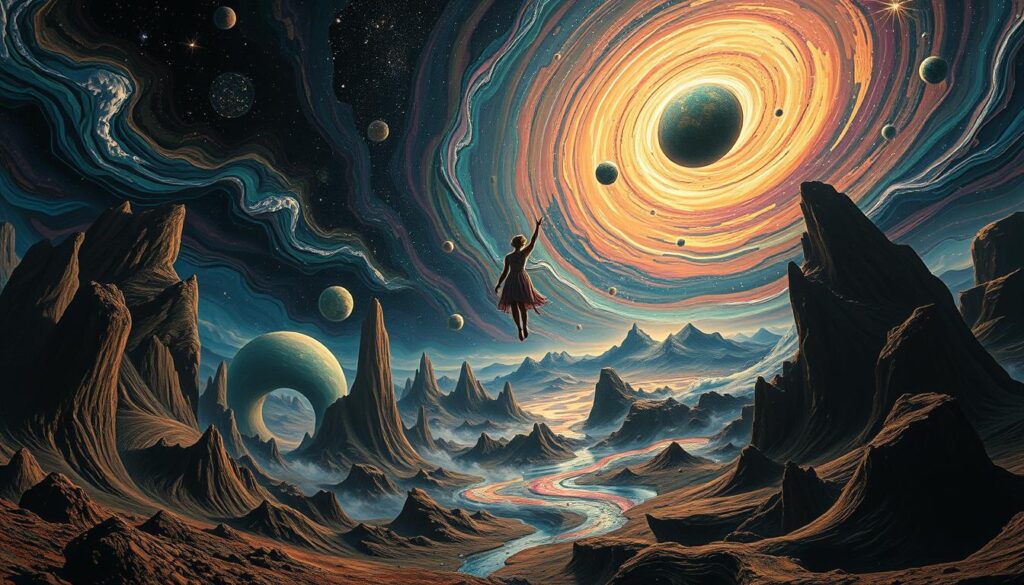
From melting clocks to floating cats, surrealism transforms everyday scenes into fantastical worlds. This section will guide you through crafting surrealist visuals and understanding its unique features.
Prompt Template for Surrealism
To create surrealist art, start with a clear vision. Use this template to guide your generation process:
- Subject: Choose a main focus, like a “fat cat” or “melting clocks.”
- Location: Place it in an unusual setting, such as a galaxy or underwater city.
- Mood: Convey emotions like mystery, wonder, or nostalgia.
- Details: Add symbolic elements or unexpected textures.
Example: A Galaxy of Melting Clocks
Imagine a scene where a fat cat floats in a galaxy surrounded by melting clocks. The dream-like quality of this design showcases surrealism’s ability to blend reality and imagination. The cat’s relaxed pose contrasts with the chaotic background, creating a sense of wonder.
“Surrealism is the art of the impossible, where dreams and reality collide.”
Surrealism also offers therapeutic applications, allowing artists to explore subconscious thoughts. Techniques like scale manipulation and multi-perspective compositions add depth to your work. Whether influenced by Dali’s whimsy or Magritte’s symbolism, surrealism continues to inspire creativity.
Impressionism: Light, Color, and Atmosphere
Impressionism captures the fleeting beauty of light and color in everyday moments. This art style focuses on the interplay of light and atmosphere, creating vivid landscapes and emotional scenes. Artists like Monet and Renoir pioneered this movement, each bringing their unique style to the canvas.

Understanding Impressionist Techniques
Impressionist works are known for their soft brushstrokes and attention to details. Seasonal light variations, like the golden hues of summer or the cool tones of winter, play a key role. Artists often painted “en plein air,” capturing the natural world in real-time.
Palette knife textures and oil vs. watercolor simulations add depth to the art. For example, Monet’s “Water Lilies” showcases fluid brushstrokes, while Renoir’s “Dance at Le Moulin de la Galette” highlights vibrant, dynamic scenes.
Prompt Template for Impressionism
To create your own impressionist scene, use this template:
- Subject: A couple dancing in a park.
- Lighting: Soft, golden hour light.
- Color Palette: Warm tones with hints of blue.
- Brushstrokes: Loose and expressive.
- Mood: Joyful and carefree.
Example: A Couple Dancing in a Park
Imagine a scene where a couple dances under blooming trees. The soft brushstrokes capture the movement of their clothes and the light filtering through the leaves. This landscape evokes a sense of joy and timelessness, showcasing the essence of impressionism.
“Impressionism is not just about what you see, but how you feel when you see it.”
By understanding these techniques, you can recreate the magic of impressionist art in your own work. Whether it’s a serene park or a bustling street, the focus on light and color will bring your scene to life.
Pop Art: Bold Colors and Cultural References
Pop art redefined visual culture with its bold colors and cultural commentary. This art movement celebrates everyday objects, turning them into vibrant statements. From Campbell’s soup cans to comic book designs, pop art blends consumer culture with creativity.
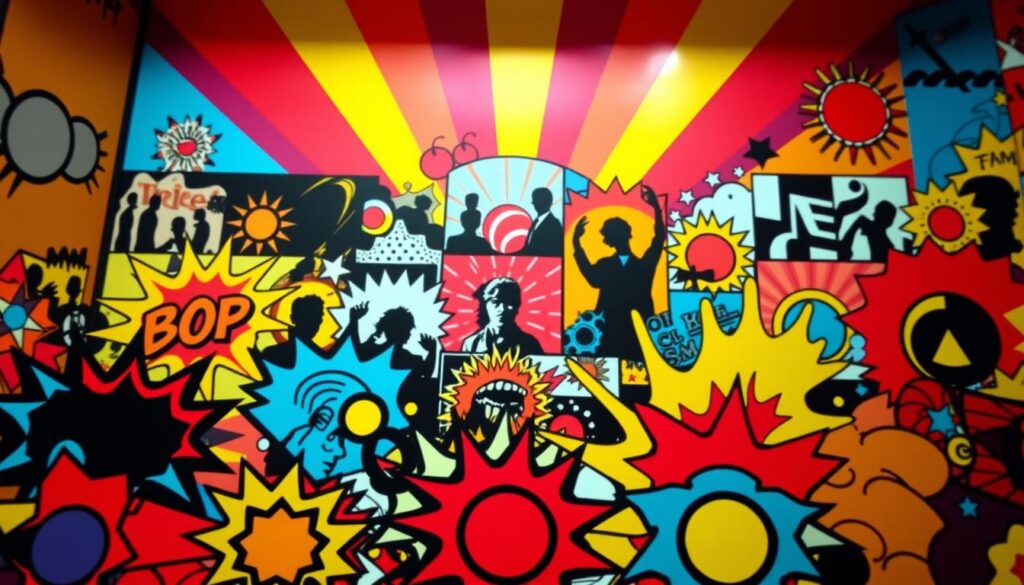
Its influence extends beyond galleries, shaping advertising and branding. By using bright hues and iconic imagery, pop art captures the essence of modern life. Below, we’ll explore how to create your own pop art masterpieces.
Prompt Template for Pop Art
To craft compelling pop art, start with a clear vision. Use this template to guide your process:
- Subject: Choose an iconic object, like a soup can or comic character.
- Color Palette: Use bold, contrasting colors for maximum impact.
- Text: Add catchy phrases or slogans for cultural relevance.
- Style: Decide between Warhol’s repetition or Lichtenstein’s comic dots.
- Background: Keep it simple to let the subject shine.
Example: A Vibrant Cityscape with Soup Ads
Imagine a cityscape filled with Campbell’s soup ads in Warhol’s style. The bold red and white patterns create a striking visual. This example shows how pop art transforms everyday objects into iconic designs.
| Aspect | Warhol Techniques | Lichtenstein Techniques |
|---|---|---|
| Color Usage | Bold, flat colors with repetition. | Primary colors with Ben-Day dots. |
| Subject Matter | Consumer products and celebrities. | Comic book scenes and emotions. |
| Text Integration | Minimal, often absent. | Speech bubbles and captions. |
Retro-modern hybrids blend classic pop art with contemporary themes. For example, combining Warhol’s soup cans with modern branding creates a fresh take on the art form. Ben-Day dots, popularized by Lichtenstein, add texture and depth to your work.
“Pop art is not just about visuals; it’s a reflection of society and culture.”
For advertising campaigns, pop art’s boldness ensures your message stands out. CMYK color conversion ensures print-ready designs, while screen printing simulations replicate traditional techniques. By following brand guidelines, you can create pop art that resonates with your audience.
Minimalism: Simplicity and Negative Space
Minimalism celebrates the beauty of simplicity and the power of negative space. This style strips away excess, focusing on essential elements to create impactful designs. Whether in art, architecture, or product designs, minimalism emphasizes clarity and purpose.
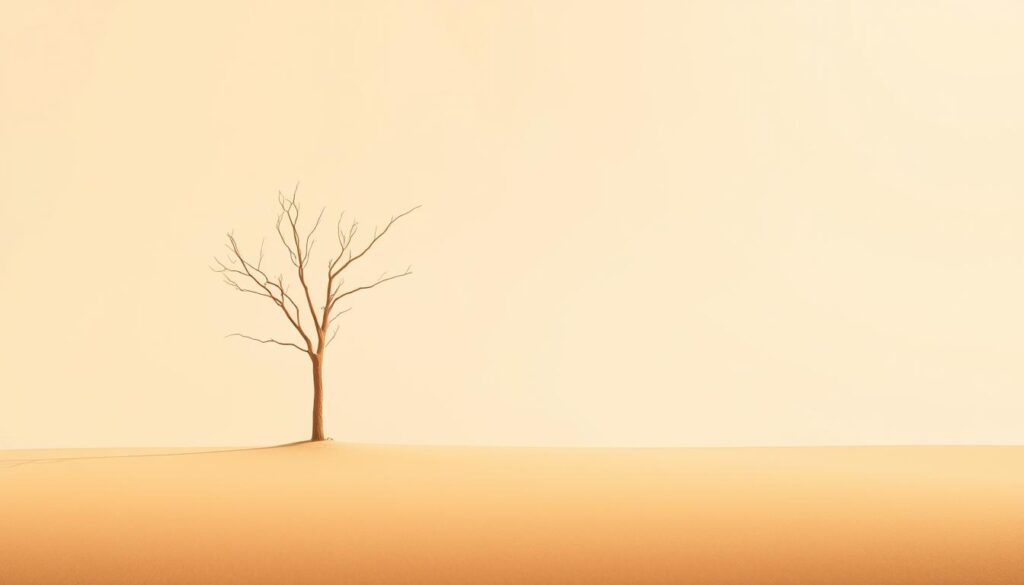
Rooted in Japanese wabi-sabi philosophy, minimalism finds beauty in imperfection and simplicity. It teaches us to appreciate the elegance of less, creating a sense of calm and focus. This approach is evident in everything from serene landscapes to sleek product designs.
Prompt Template for Minimalism
To create minimalist images, use this template:
- Subject: A single tree in a serene landscape.
- Color Palette: Monochromatic tones for harmony.
- Negative Space: Maintain a 70/30 ratio for balance.
- Details: Focus on clean lines and simplicity.
- Mood: Calm and contemplative.
Example: A Single Tree in a Serene Landscape
Imagine a lone tree standing in a vast, open field. The monochromatic palette enhances the image’s tranquility, while the 70/30 negative space ratio draws attention to the tree. This example showcases how minimalism creates powerful visuals with simplicity.
| Aspect | Scandinavian Minimalism | Brutalist Minimalism |
|---|---|---|
| Materials | Light wood, soft textiles. | Concrete, raw metals. |
| Color Palette | Neutral tones, pastels. | Monochromatic, earthy hues. |
| Mood | Warm and inviting. | Bold and industrial. |
Minimalism also excels in luxury product designs, where quality and craftsmanship take center stage. For instance, Apple’s product campaigns highlight sleek, minimalist designs that resonate with consumers. Similarly, architectural visualization benefits from minimalism’s focus on clean lines and open spaces.
“Minimalism is not about having less; it’s about making room for what truly matters.”
For website hero images, minimalism ensures clarity and focus. A simple, well-composed image can convey your message effectively, without overwhelming the viewer. By mastering minimalism, you can create designs that are both elegant and impactful.
Cubism: Abstract and Geometric Forms
Cubism redefined the way we perceive reality, breaking it into abstract and geometric forms. This revolutionary art movement, pioneered by Picasso and Braque, challenged traditional perspectives and introduced a new way of seeing the world. By fragmenting objects into bold shapes and intersecting planes, cubism created dynamic and thought-provoking designs.
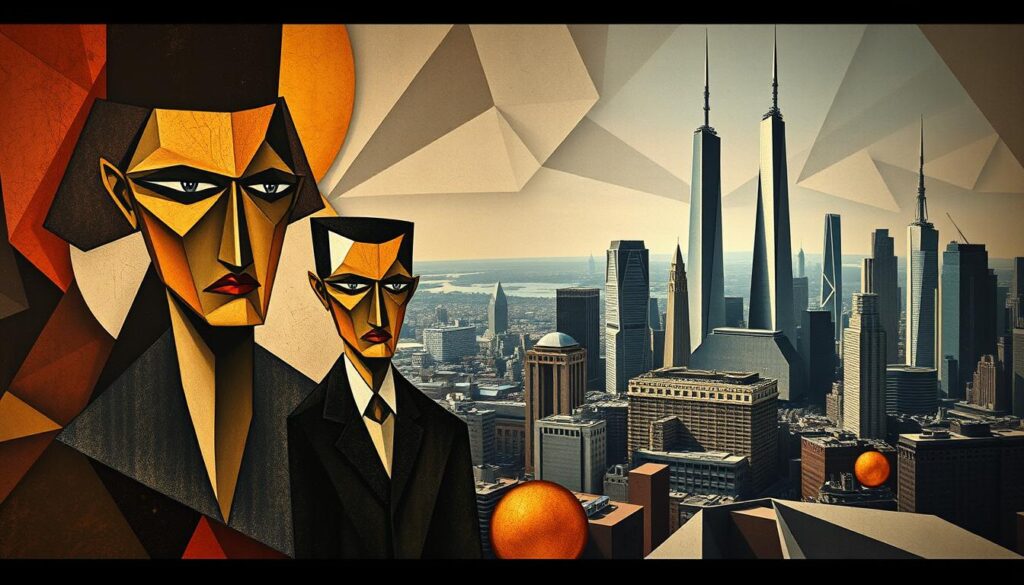
This section explores the features of cubism, from its analytical and synthetic phases to its influence on modern art. Whether you’re an artist or an enthusiast, understanding cubism can inspire your creative process.
Prompt Template for Cubism
To create cubist art, start with a clear vision. Use this template to guide your generation process:
- Subject: A musician in a lively café.
- Shapes: Use bold, geometric forms to break down the subject.
- Perspective: Incorporate multiple viewpoints for depth.
- Color Palette: Choose monochromatic or polychromatic tones.
- Details: Add intersecting planes and abstract textures.
Example: A Musician in a Lively Café
Imagine a scene where a musician plays in a bustling café. The art breaks the figure into bold shapes and intersecting planes, capturing the energy of the moment. This example showcases cubism’s ability to transform ordinary scenes into dynamic designs.
Cubism also influenced textile patterns and 3D sculpture. For instance, Picasso’s analytical cubism focuses on deconstructing forms, while Braque’s synthetic phase emphasizes collage-like compositions. Multi-perspective face generation adds depth, making the subject more engaging.
“Cubism is not just an art style; it’s a new way of seeing the world.”
From album covers to political art, cubism’s impact is undeniable. Guernica-inspired works highlight its power to convey complex emotions. By mastering cubist techniques, you can create designs that are both innovative and impactful.
Futurism: Movement, Technology, and Modernity
Futurism captures the essence of progress, blending movement, technology, and modernity into dynamic visuals. This art style celebrates the speed and energy of the modern world, offering a glimpse into the future. From sleek vehicle designs to bustling urban scenes, futurism inspires innovation and creativity.
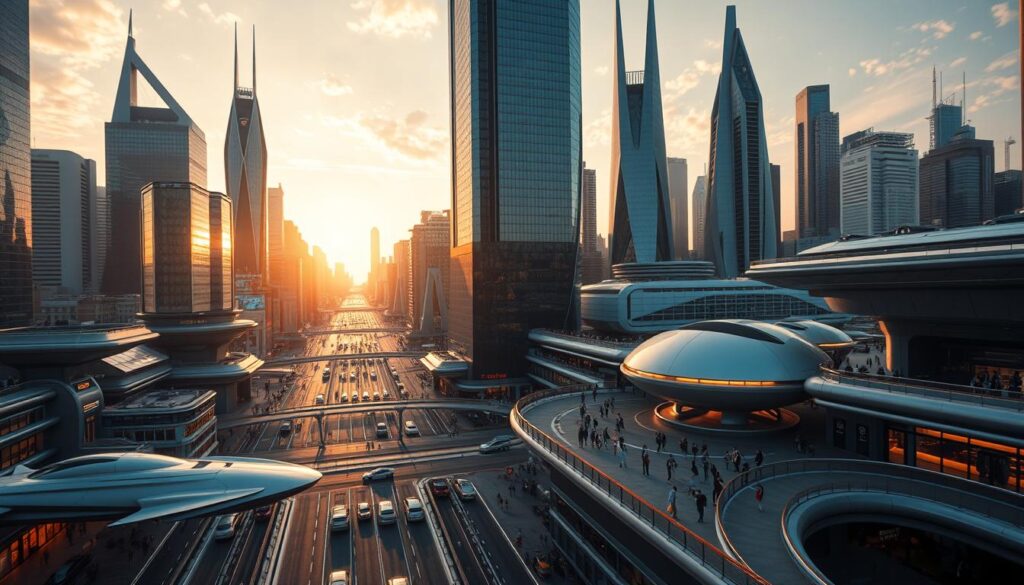
One of its defining features is the use of motion blur techniques, inspired by artists like Boccioni. These methods bring a sense of speed and fluidity to the image, making it feel alive. Whether you’re visualizing a futuristic city or enhancing sports photography, futurism offers endless possibilities.
Prompt Template for Futurism
To create compelling futurist visuals, use this template:
- Subject: A runner in a futuristic city.
- Movement: Add speed lines and motion blur for dynamism.
- Technology: Incorporate advanced gadgets or vehicles.
- Mood: Convey energy and progress.
- Details: Highlight architectural innovations.
Example: A Runner in a Futuristic City
Imagine a scene where a runner dashes through a neon-lit city. The motion blur enhances the sense of speed, while futuristic skyscrapers tower in the background. This example showcases how futurism blends movement and technology to create captivating designs.
Futurism also influences urban planning and vehicle designs. For instance, AI-assisted architectural concepts can simulate futuristic scenes, helping designers visualize innovative spaces. Kinetic sculptures and cyberpunk aesthetics further expand its creative potential.
“Futurism is not just about the future; it’s about the energy and possibilities of today.”
By mastering these techniques, you can create visuals that inspire and captivate. Whether you’re enhancing sports photography or designing futuristic landscapes, futurism offers a unique perspective on modernity.
Art Deco: Sleek and Luxurious Designs
Art Deco emerged as a symbol of sophistication, blending sleek lines with luxurious elements. This iconic style dominated the 1920s and 1930s, influencing architecture, fashion, and product designs. Its geometric motifs and bold patterns continue to inspire modern creativity.

From the Chrysler Building’s spire to Rockefeller Center’s grandeur, Art Deco’s architectural details remain timeless. Its influence extends to jewelry, where intricate patterns and symmetry create stunning pieces. Luxury packaging also benefits from its elegant style, making products stand out.
Prompt Template for Art Deco
To create Art Deco-inspired visuals, use this template:
- Subject: A Paris café terrace with geometric motifs.
- Color Palette: Gold, black, and ivory for a luxurious feel.
- Patterns: Use stylized zigzags and sunbursts.
- Details: Add symmetrical designs and metallic accents.
- Mood: Sophisticated and glamorous.
Example: A Paris Café Terrace
Imagine a Paris café terrace adorned with Art Deco patterns. The geometric railings and gold accents create a luxurious atmosphere. This example showcases how Art Deco transforms ordinary spaces into elegant designs.
Font style pairings, like Bifur and Broadway, enhance the Art Deco aesthetic. Modern interpretations often blend these fonts with minimalist details, creating a fresh yet nostalgic look.
“Art Deco is not just a style; it’s a celebration of modernity and elegance.”
Hotel branding often draws from Art Deco’s glamour. For instance, The Great Gatsby-inspired visuals use its patterns and details to evoke the Roaring Twenties. By mastering Art Deco techniques, you can create visuals that are both timeless and innovative.
Abstract Expressionism: Spontaneity and Emotion
Abstract Expressionism is a bold exploration of spontaneity and raw emotion. This art movement emerged in post-war America, breaking free from traditional constraints to focus on the artist’s inner world. It’s about translating feelings into visual form, creating works that resonate deeply with viewers.
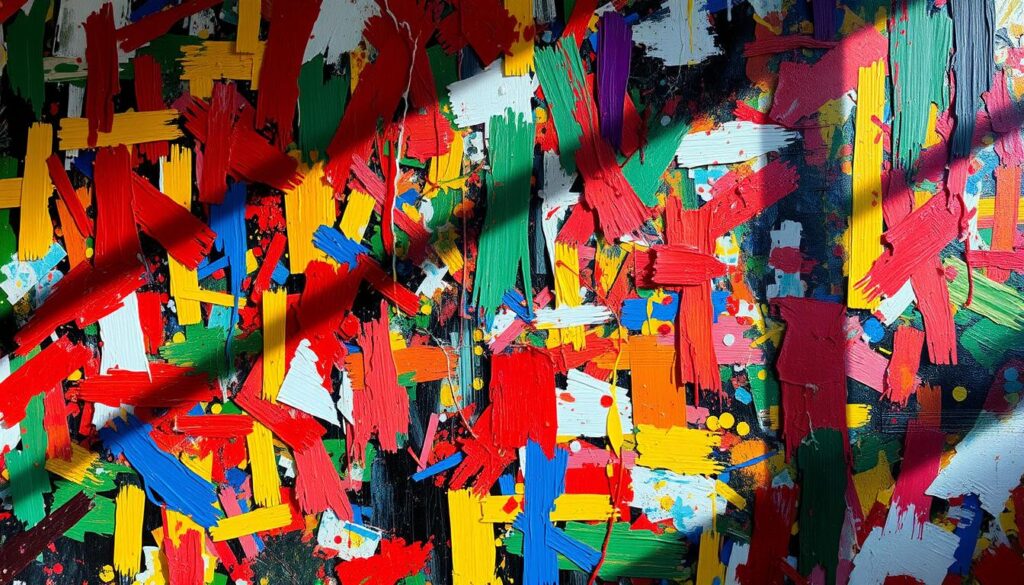
Two key techniques define this style: action painting and color field. Jackson Pollock’s drip paintings exemplify action painting, where bold brushstrokes and dynamic movements capture energy. Mark Rothko’s color field works, on the other hand, use large blocks of color to evoke emotion and contemplation.
Prompt Template for Abstract Expressionism
To create your own Abstract Expressionist piece, use this template:
- Emotion: Choose a feeling like freedom, chaos, or serenity.
- Technique: Decide between action painting or color field.
- Color Palette: Use bold or muted tones to match the mood.
- Scale: Consider large canvases for maximum impact.
- Details: Add textures or layers for depth.
Example: The Concept of Freedom
Imagine a canvas filled with bold, sweeping brushstrokes in vibrant blues and whites. The art captures the essence of freedom, with dynamic movements and layered textures. This example showcases how Abstract Expressionism can translate abstract concepts into powerful visuals.
Abstract Expressionism also has practical applications. Large-scale murals bring this style to public spaces, while art therapy uses its techniques to help individuals express emotions. Digital tools now allow artists to experiment with this style without traditional materials.
| Aspect | Action Painting | Color Field |
|---|---|---|
| Technique | Dynamic brushstrokes, drips. | Large blocks of color. |
| Emotion | Energy, chaos. | Calm, contemplation. |
| Scale | Often large canvases. | Can vary in size. |
“Abstract Expressionism is not just about what you see; it’s about what you feel.”
Market value for Abstract Expressionist works depends on factors like artist reputation, generation, and historical significance. Gallery wall compositions often group pieces by theme or color to create a cohesive display. Whether you’re an artist or an enthusiast, this style offers endless possibilities for creative expression.
8-Bit Art: Nostalgic and Pixelated
8-bit art brings a nostalgic charm with its pixelated aesthetics. This art style, rooted in classic gaming, continues to captivate audiences with its simplicity and retro appeal. From character designs to vibrant scenes, 8-bit art offers a unique blend of creativity and nostalgia.
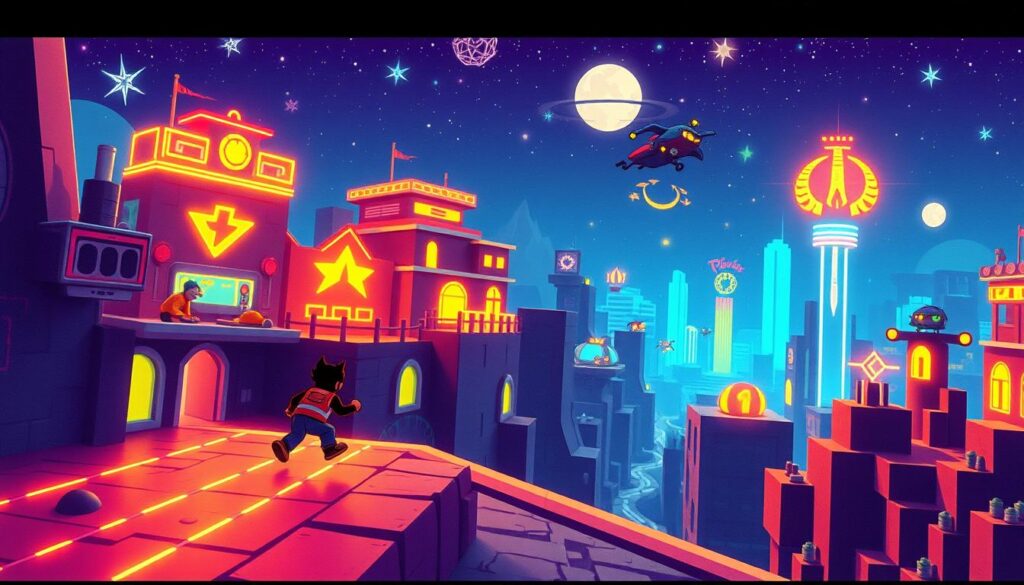
Prompt Template for 8-Bit Art
To create your own 8-bit masterpiece, use this template:
- Subject: A knight battling a dragon.
- Color Palette: Limited to 16 colors for authenticity.
- Details: Add pixelated textures and retro shading.
- Mood: Heroic and adventurous.
- Background: A medieval castle or dungeon.
Example: A Knight Battling a Dragon
Imagine a scene where a knight wields a sword against a fiery dragon. The pixelated designs and limited color palette evoke the charm of classic NES games. This example highlights how 8-bit art can bring epic stories to life.
Modern applications of 8-bit art include chiptune album covers and Twitch overlays. Indie games like “Shovel Knight” showcase how this style can thrive in today’s gaming world. By blending retro elements with contemporary techniques, artists create neo-pixel hybrids that appeal to both old and new audiences.
| Aspect | 8-Bit Art | 16-Bit Art |
|---|---|---|
| Color Palette | Limited to 16 colors. | Up to 256 colors. |
| Detail Level | Simplified, pixelated. | More detailed and refined. |
| Applications | Retro games, chiptune art. | Modern indie games, animations. |
“8-bit art is more than just pixels; it’s a celebration of gaming history and creativity.”
From tile set creation to retro UI elements, 8-bit art offers endless possibilities. Whether you’re designing a game or creating a nostalgic video, this style ensures your work stands out. By mastering its techniques, you can create designs that resonate with audiences of all ages.
Claymation: Whimsical and Handcrafted
Claymation brings a unique charm with its handcrafted and whimsical designs. This art form uses clay to create characters and scenes, resulting in a tactile and nostalgic visual experience. From children’s books to feature films, claymation continues to captivate audiences with its playful and creative approach.
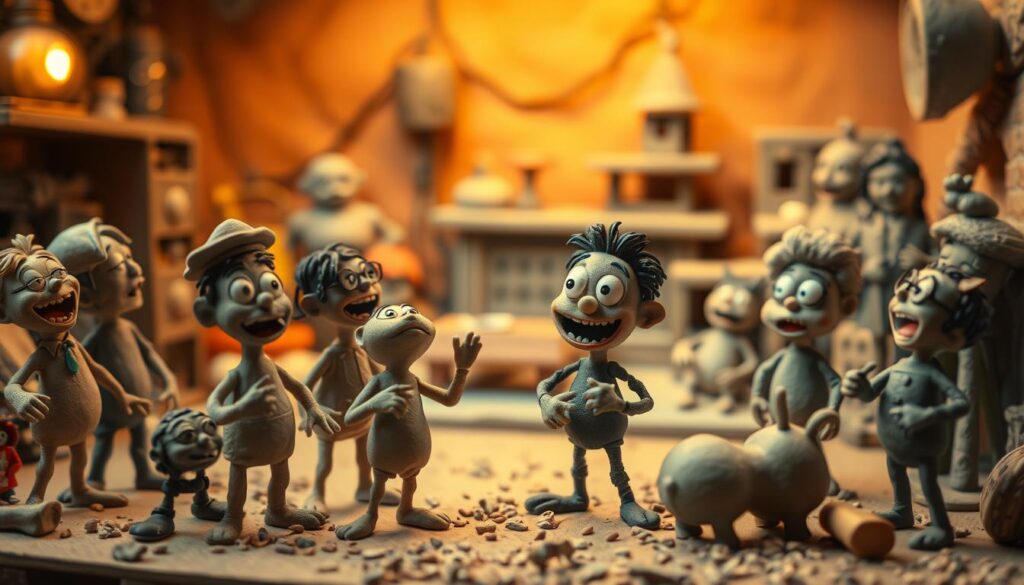
Prompt Template for Claymation
To craft your own claymation scene, use this template:
- Subject: A dinosaur in a prehistoric jungle.
- Details: Include vibrant colors and 3D textures for depth.
- Mood: Adventurous and whimsical.
- Background: A lush, green jungle with handcrafted elements.
Example: A Dinosaur in a Prehistoric Jungle
Imagine a scene where a clay dinosaur roams a vibrant jungle. The handcrafted textures and 3D details bring the character to life. This example highlights how claymation can create engaging and imaginative designs.
Aardman Studios, known for Wallace & Gromit, has significantly influenced this art form. Their attention to details and character design sets a high standard for claymation. Hybrid techniques, combining digital and traditional methods, have further expanded its creative potential.
| Aspect | Traditional Claymation | Hybrid Techniques |
|---|---|---|
| Materials | Clay, wireframes. | Clay with digital enhancements. |
| Process | Frame-by-frame animation. | Digital compositing and effects. |
| Applications | Short films, commercials. | Feature films, interactive media. |
“Claymation is not just an art form; it’s a celebration of creativity and craftsmanship.”
From children’s book illustrations to modern animations, claymation offers endless possibilities. Its tactile and whimsical nature ensures it remains a beloved art form for generations to come.
Conclusion: Elevate Your AI Art with ChatGPT and DALL-E
Exploring the intersection of technology and creativity reveals endless possibilities. By mastering style differentiation strategies, you can create unique visuals that stand out. Whether it’s surreal landscapes or minimalist designs, understanding your tools is key.
Comparing models like DALL-E 3 and Midjourney highlights their strengths. DALL-E 3 excels in text rendering, while Midjourney delivers superior facial details. Choosing the right tool ensures the best results for your projects.
Ethical considerations are crucial in AI-driven art. Always credit your sources and respect intellectual property. Integrating these tools into your workflow can streamline your creative process, saving time and effort.
Experiment with different techniques to build a diverse portfolio. Stay updated on upcoming features to keep your work innovative. Start exploring today and unlock the full potential of image generation.

